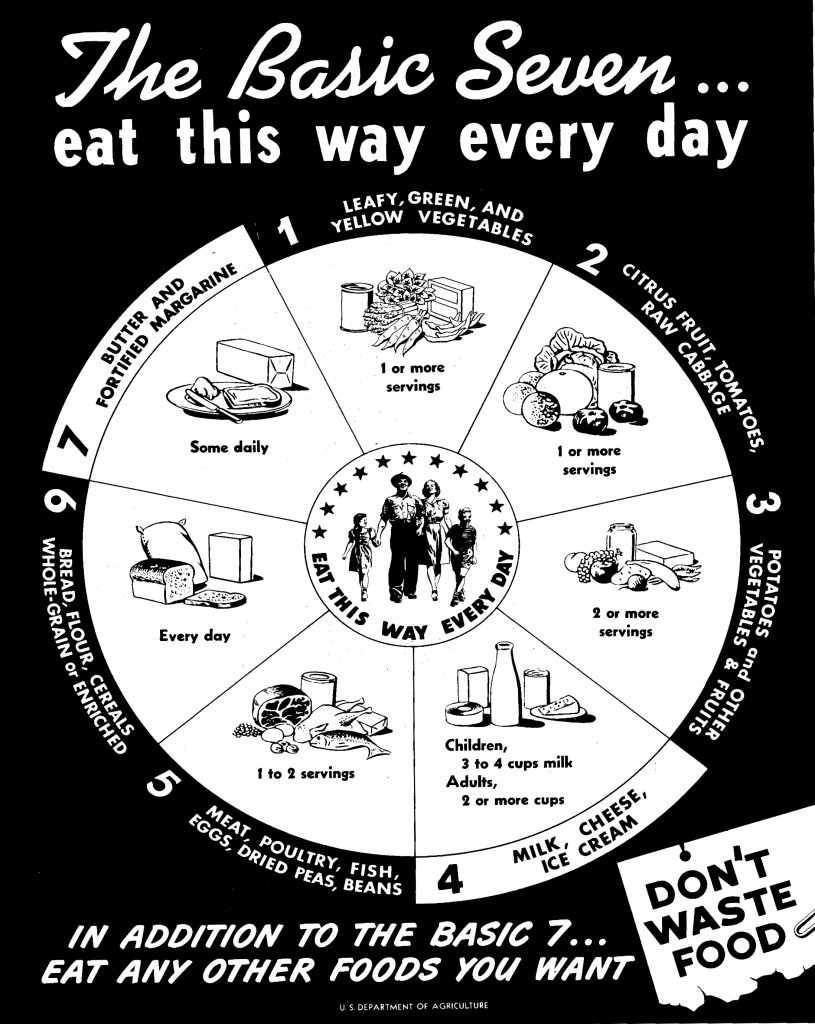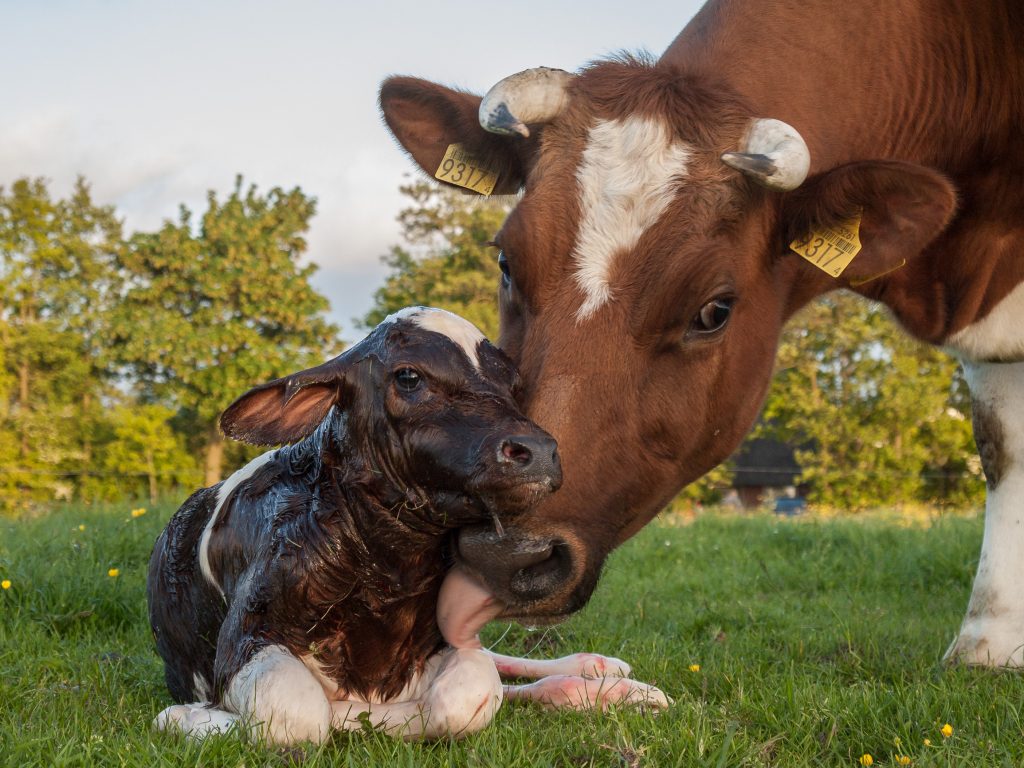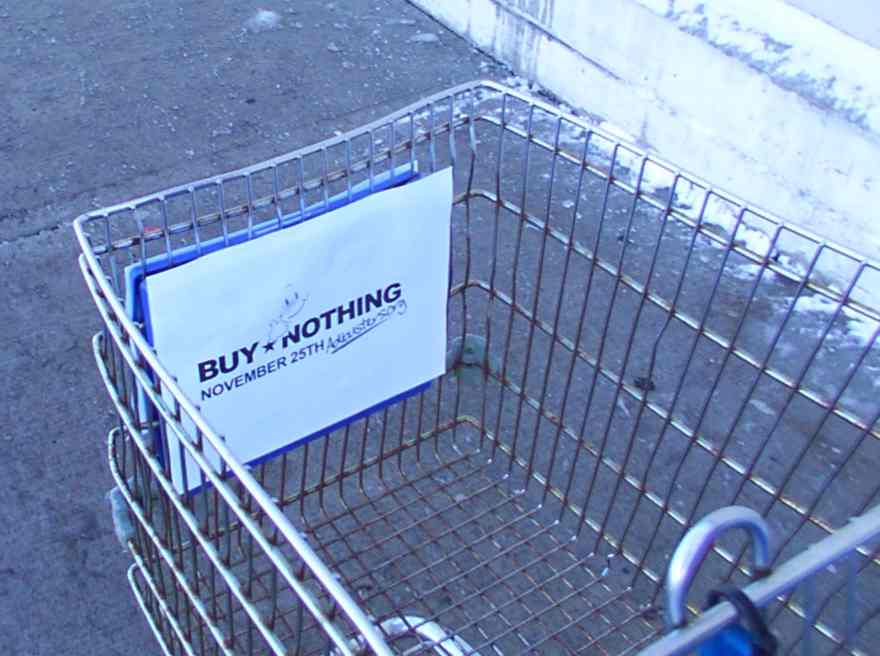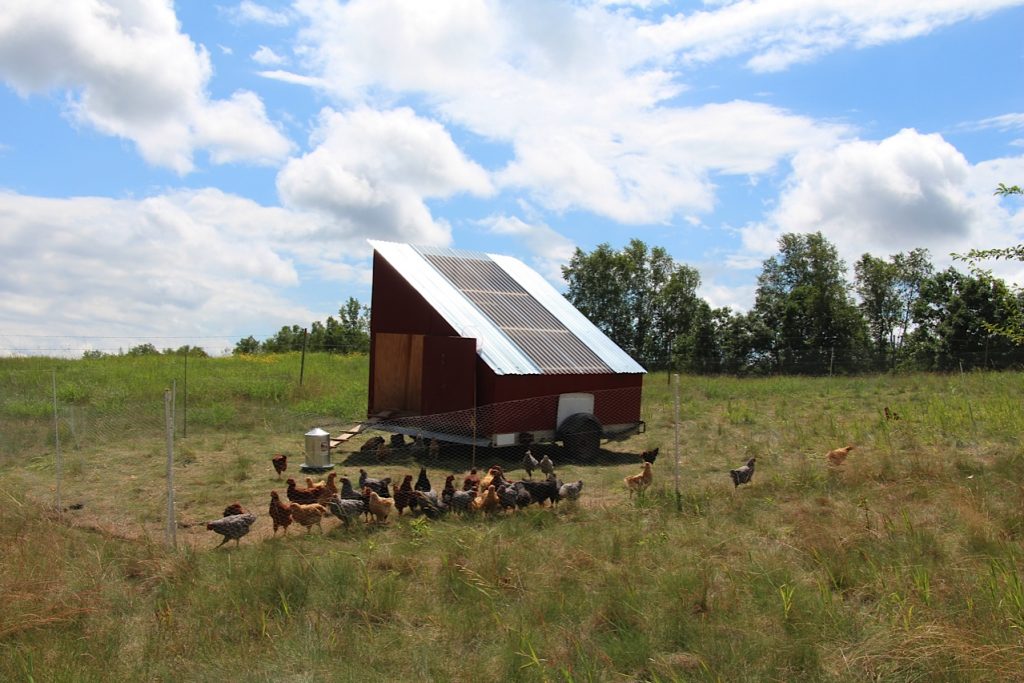15 Food and Choice
Sometimes Environmental History can be a frustrating or even a depressing topic of study. Many of the interactions between people and their environments we have explored in this course have been stories of tragedy and disaster, and the environmental future we and our children face will probably be challenging. In this final chapter, we are going to ask whether individuals can do anything to influence American society’s relationship with its environment for the better. Specifically, we will examine food.
The exact relationship between history and the present is something not all historians agree about. Just because things turned out the way they did, we are not compelled to believe this outcome was inevitable. And although most historians try to avoid using overly simplistic “lessons” from history to argue about what we should do in the present, most would also agree that we study the past to learn about our present circumstances and about how to choose the best future. Over the years I have spoken with many teachers of Environmental History and they have usually expressed two interests. First, trying to end the semester on a positive or at least on a hopeful note. And second, trying to turn all the information we’ve covered in Environmental History toward the question, “Okay, here we are, so what should we do now?

Here are some examples. In April 2014, a Supreme Court decision called McCutcheon v. FEC (Federal Elections Commission) effectively eliminated limits of campaign contributions. In other words, the the new law says more money you have, the more influence you should have in the political process. Whether that actually changes anything or simply acknowledges a reality that has existed for some time remains to be seen, but either way McCutcheon shows how little impact individuals have in our current political system. The Supreme Court Decision is particularly bad news for the environment. The plaintiff in the case, Sean McCutcheon, is CEO of an Alabama-based corporation called Coalmont Electrical Development. As the name suggests, McCutcheon’s company is a contractor working primarily with mining and utility companies. McCutcheon brought the suit because he opposed the $117,000 limit on aggregate contributions in a national campaign cycle. The coal-based energy industry had a lot of money to spend opposing what they called “President Obama’s War on Coal” and they desperately wanted to pack the government with people who would support their coal mining and their coal-fired power plant agendas. Since the 2016 election, the coal industry has had allies in the highest national offices. We’ll see if that saves the coal industry or just delays its end.
One place where actual voters seem to have a little bit more power is California, which has a ballot proposition system that allows proposed laws to be submitted directly to the people for a vote. In the 2012 election there were eleven propositions on the California ballot and in 2016 there were eighteen statewide initiatives ranging from marijuana legalization and gun control to tobacco taxes and educational bonding. In 2016 twelve of the sixteen propositions passed; in 2012 only five passed and six failed. One of the failed 2012 initiatives was Proposition 37, which called for GMO (Genetically Modified Organism) food labeling. GMO labeling was supported by a few food-related companies like Whole Foods, Organic Valley, and Annies (at the time a publicly-traded corporation making organic macaroni and cheese, bought out by General Mills in 2014). Advocates for Prop. 37 raised $8.7 million to use in their media campaign supporting labeling. Their basic message was not that GMOs should be banned, but simply that people had the right to know what was in their food. Opponents of the labeling law raised $46.5 million, the biggest contributor being Monsanto whose $8 million contribution was nearly equal to all the money raised by proponents. The list of companies that contributed more than $150,000 to block GMO labeling is a who’s-who of food manufacturers and chemical companies. At the top of the list, below Monsanto, was DuPont ($5.4 million), Pepsico ($2.1 million), The Grocery Manufacturers Association, DOW Agrisciences, Bayer Cropscience, BASF, and Syngenta (all contributing $2 million). Kraft Foods, Coca-Cola, Nestle, Conagra, General Mills, Kellogg, Smithfield, Del Monte, Campbell’s Soup, and Heinz all contributed between a half million and two million dollars to defeat GMO labeling. Even Ocean Spray Cranberries threw in $387,000.

All these companies believed GMO labeling would be bad for their bottom line, and that a California law might lead to more labeling laws across America. So it is fair to assume they all use GMOs to some extent, and that they would prefer for their customers not to know the actual extent of their GMO use. It is unclear, of course, exactly what effects foods containing GMOs actually have on nutrition and on the health of the people who eat them. But in a large part, that mystery is due to a lack of research at universities and regulatory organizations that rely on the industry for most of their grant funding and personnel. However, we should note that in spite of being outspent 5 to 1 by labeling opponents, Prop. 37’s advocates garnered over six million votes or 48.6% of the final tally. Nearly half of California voters wanted to know what was in their food. The proposition almost passed — but if a GMO labeling law can’t pass in California, what hope is there for a legislative solution anywhere else?
The good news is that California consumers and their allies in other states now have a detailed list of the few food companies that supported and the many that opposed labeling, which they can use to make decisions about what to buy. Even if some GMOs turn out to be harmless, the corporations that opposed labeling have identified themselves with the cause of reducing transparency and making it harder for their customers to make informed purchase decisions. The California election results suggested to many activists that if people are going to change the food system in today’s political environment, it won’t be through government action. Luckily, no one is actually holding a gun to our heads forcing us to eat Smithfield meat, General Mills Cheerios, or Del Monte canned beans. Everybody eats, but somehow most of us have forgotten we can vote with our food dollars. Partly this is because the food industry has been seducing us for decades with inexpensive, tasty treats. But if six million Californians stopped drinking Coke and Pepsi products or eating Kraft’s Mac & Cheese, Lunchables, and Velveeta, would that be a more effective method of voting for change than Prop. 37?

Humans are hard-wired by evolution to crave fat, sweets, and salt because those were the essential nutrients that were scarcest in our diets. Nowadays, they’re just cheap ingredients for food manufacturers. And as anyone who has been to cooking school will tell you, the easiest way to make anything taste good is to add fat. Even bland water chestnuts can become tasty hors d’ouevres if you wrap them in bacon. And if a normal helping of fat and salt isn’t enough to attract consumers, manufacturers can add even more fat or some sugar on top. Have you noticed the recent explosion of “sweet and salty” and “barbecue” flavors that add sugar, on top of the already wide assortment of “nacho cheese” and “sour cream and onion” flavored chips on supermarket and convenience store shelves?
An element of the food puzzle that causes a lot of disagreement is meat. Americans eat about 270 pounds of meat every year per capita. That’s more than anyone else except Australians and, oddly, citizens of Luxembourg. Our consumption of beef peaked in the mid-1970s and since then chicken has steadily increased until it finally overtook beef in the last few years. For a while food experts claimed that a chicken dinner was actually healthier than a burger or a steak. But most of the chicken consumed in America today is eaten in the form of nuggets, buckets, and wild wings. And in terms of farming practices and environmental impact, chicken and beef are very similar. Both are raised in large-scale confinement facilities (CAFOs) where the animals are fed a diet of corn and antibiotics. Then they, along with pigs and turkeys, are shipped to processing factories that are increasingly owned by just a couple of global corporations such as Tyson, JBS of Brazil, and the Shuanghui Group of China, which recently bought US meat processor Smithfield Foods’s pork operation for $4.7 billion (JBS bought Smithfield’s beef operation in 2009).

We examined the growth of the meat-packing industry in Chapter 7 and noticed that a major factor in the success of the Chicago industry was the introduction of USDA inspection. The government is still responsible for inspecting food products at taxpayer expense, but the agencies given the task of insuring food safety don’t have the budgets or manpower to do the job very effectively. Most problems with food are discovered only when someone becomes sick. The US Food and Drug Administration (FDA) maintains an online list of product recalls and safety alerts. Most of the food products on the bulletin either contain an unlisted ingredient like milk or peanuts that might be dangerous to consumers with allergies, or they are contaminated. The most common contaminants are salmonella and listeria. The USDA maintains its own list, and most of the food products it recalls either contain unlisted allergens or contain salmonella or E. coli. It’s important to note that when the USDA and FDA recall a food product, on the average 63% of the product recalled is not recovered from store shelves, and is sold through to consumers.
The Escherichia coli 0157:H7 variety that is found in many meat products is an enterohemorrhagic strain that causes bloody diarrhea and kidney failure, and can be fatal. Recent research discovered that this strain can bind to plant surfaces (like the skins of fresh fruit and vegetables) and can colonize the roots of lettuces and spinach plants in commercial operations. In 2001 a two-year old boy named Kevin Kowalcyk died of hemolytic uremic syndrome after eating an E. coli-infected hamburger. Legislation called Kevin’s Law designed to strengthen the USDA’s ability to shut down packing plants that have multiple health violations was defeated a couple of years later by the meat industry. But some of the elements of Kevin’s Law were included in an FDA Food Safety Modernization Act that finally passed in 2011. Unfortunately, according to Barbara Kowalcyk (who has a Ph.D. in Epidemiology and Biostatistics and is also the dead boy’s mother who founded the Center for Foodborne Illness Research and Prevention), “The FDA does not currently have sufficient resources to implement the new provisions.”
In addition to the danger of contamination, meat has been criticized by some food activists as a ridiculous waste of resources. According to The Journal of Animal Science, a quarter-pound hamburger takes 6.7 pounds of feed and over 50 gallons of water to produce. Multiply that by the “billions and billions” served by just one major fast food chain, and you begin to see the magnitude of the issue. Most critics of meat estimate that the ratio is about 10 to 1. Ten people, they claim, could be fed plant products using the resources used to feed one person meat. The 10:1 ratio argument has been embraced by Vegans as proof that their diet is the only way to feed all the people of the world. But is this an argument against meat per se, or against meat produced the way we make it now?

In a recent book called Meat: A Benign Extravagance, British author Simon Fairlie coined the term “default livestock” to describe animals raised in a more traditional and, he argued, more sustainable way. Animals, Fairlie observed, have historically been fed things that humans either could not eat or chose not to eat. Ruminants such as goats, sheep, and cattle, grazed on pastures that were either fallow fields in a crop rotation system or hillsides and rangelands unfit for planting. Pigs and chickens ate leftovers and byproducts like peelings and the mash left after a batch of beer or wine was made. Or they ate foods like acorns and fallen fruit that humans could consume but usually can’t be bothered with. If meat production was taken out of CAFOs and returned to this historic “default,” Fairlie argued, people could still enjoy a diet including some meat. The portions would be a bit smaller, but they would be healthier and they’d be sustainable.
As we’ve already seen, CAFOs and corn-fed livestock are the results of subsidies that make it cheaper for a farmer to buy feed than to grow it. But they are also a result of consumer decisions. When we buy a Smithfield pork tenderloin at the Walmart to grill, Americans generally do not think about how the animals were raised and slaughtered. We are unaware of the conditions in the packing plant, where workers who are often illegal aliens working for low wages are judged on speed and on the number of animals they can put through the system in a day. According to a recent book, an animal was killed every 12 seconds at the head of the “disassembly line” where the author was stationed. We are not even aware that the profits from that Smithfield pork loin are going to end up in the Brazilian bank accounts of JBS S.A. rather than in the hands of the American farmer or processors who made the product.
A growing number of Americans, however, are visiting farmers markets and buying shares in CSAs (Community Supported Agriculture). They are taking the opportunity to eat more fresh vegetables and locally produced meat,and eggs. In some cases they are even getting raw milk, although the food safety laws that were designed to protect the public from distant, anonymous food processors now sometimes prevent people from buying food from their neighbors unless those products have gone through a similar regime of of processing and inspection. One of the big barriers preventing more people from selling farm products locally is the time and expense involved in obeying all the rules and laws written to regulate global corporations. Another barrier is the cost of land and equipment. An acre of farmland that is anywhere near an American city is usually priced like a suburban house lot, because the alternative to planting it is building a new subdivision. And when starting as a commercial chicken farmer means that you have to build a confinement building to the specifications of the company that sends you a couple hundred thousand day-old chicks, often the only way to get going is to become what amounts to an indentured servant of a poultry company like Tyson. As a result, the average age of the American farmer is now well over 60.

With these costs in mind, farmers like Virginian author Joel Salatin are beginning to design systems that can be started at a reasonable commercial scale without much capital investment, and that are portable. Salatin’s chicken and turkey “tractors” can be hitched to a pickup truck and hauled to pastures where the farmer is going to raise the birds. This scheme allows a farmer to grow thousands of premium-priced free range birds on rented land. Salatin himself inherited a 500-acre farm in Virginia’s Shenandoah Valley, but to his credit he understands that’s not the way a new generation of sustainable farmers is going to be created. Salatin says that the electric mesh fence and battery-based fence charger he uses may be the most important agricultural innovations in decades (I use them too, and I agree). The fence controllers use microchips to pulse the electrical charge in millisecond increments, preventing the lightweight fence material from melting and allowing fences to be powered by 12-volt rechargeable batteries. This means fences can be set up quickly and moved easily. Animals can be contained and protected from predators far from permanent electrical sources, and can be rotated through fields with unprecedented flexibility. Salatin has designed a grazing rotation using cattle and chickens that he believes could be scaled up to a level where it could actually feed the world.
Scalability is an important issue in this new style of local farming. Critics have argued for decades that farmers markets and CSAs are elite institutions that appeal only to affluent liberals who can afford to spend more than necessary to support local farming for political reasons — but are irrelevant in the “real world” where we have to feed everybody. Feeding the world a diet equivalent to that of a typical American, they say, would take 90% of the available land area. The key, of course, is that feeding everyone like a typical American isn’t what locavores have in mind. Advocates of local solutions believe everyone’s diet needs to change. Fairlie’s idea of default livestock and Salatin’s claim that his grassfed cattle and chicken operation could be scaled up are at least a starting point for discussing a new food system. Sustainable food advocates like Michael Pollan are quick to point out that changing our eating habits produces immediate health benefits as well as long-term social benefits. “Eat food. Not too much. Mostly plants.” is the motto of Pollan’s 2008 bestseller, In Defense of Food. Pollan argues that the food system is going to change, because it is unsustainable. As fossil fuel costs rise, fertilizer production, farm-equipment operation, food processing, and transportation will all become more expensive. The average American’s food travels over 5,000 miles from farm to fork. The typical grocery cart is filled with out-of-season fruits and vegetables, many of which cross the equator on their way to the supermarket. Millions of pounds of perishable produce are actually shipped by jet because they would never make it to market before spoiling if they went by container ship. So jet fuel is actually part of the social cost and the carbon footprint of the pint of strawberries I might buy in Minnesota in January.
A lot of time and energy go into subsistence farming, and we have come a long way since the days when nearly everyone was a farmer in Early American society. Very few people want to give up their careers and their interests and live like the pioneers did in the eighteenth and nineteenth centuries. Although many Americans may decide to supplement their diets with vegetables from a garden or with eggs and meat from a backyard henhouse, the food industry will likely be where the most significant changes are made (or not made) in the future. So the question is, can consumers influence the food industry in ways that will lead to healthier food choices and increased sustainability?

For some people, lifestyle is politics. Conspicuous consumption makes as statement, as does living out of dumpsters. Between these two extremes are a lot of alternatives, and they have changed over time. “Baseball, hot-dogs, apple pie, and Chevrolet” was once a popular advertising slogan. Since then, the old fashioned conservative value of “Buy American” has gone so far out of style (in reality, if not always in rhetoric) that no one would seriously consider running a national advertising campaign in which the product’s American-ness was its most important attribute. In recent years, an organization called Adbusters has sponsored an annual, national anti-consumerism boycott, calling on people to buy nothing on “Black Friday,” the day after Thanksgiving. Buy Nothing Day was an event for several years, and is still observed by some critics of consumerism. Perhaps “sustainable” might be a better concept for people to build a movement around, rather than GMO-free. The science is still unresolved regarding GMOs, as mentioned earlier. But for many people, the issue with GMOs isn’t really genetic modification per se, as much as the idea that global corporations like Syngenta and Monsanto should not be patenting genomes and manipulating them behind a veil of secrecy and government protection that destroys transparency and makes people paranoid.
Organic is another difficult concept. Given the choice between a certified organic bag of chips and a regular one, what are we actually choosing? Which bag of chips is better for the environment, if the regular chips are local and the certified organic ones had to be shipped all the way from a factory in California? And in any case, are either of the bags of chips actually any good for us? Sustainability, as a concept, has the additional advantage that it may actually be measurable and we may be able to ask questions based on those measurements about how our choices affect sustainability at both a personal and societal level. How do my personal choices about food, or about which car to drive, or about how to heat my house influence my ability to sustain my family’s lifestyle? Does our social choice to subsidize corn increase or decrease the sustainability of our food system? If nothing else, discussions about sustainability would tend to focus our attention on the long term and on those economic externalities we usually fail to see.

I’m not sure how much of an answer that is. But for my part, I’m going to continue planting a garden and raising chickens so I know where the meat I feed my family comes from. I may also stop buying from those companies on the list of corporations that opposed labeling in California. If a lot of people did that, it might be a more effective way to change their behavior than through a government that is pretty much owned by those corporations. Now all I have to do is convince a few million of my fellow consumers to join me! But seriously, maybe that’s easier these days than representative democracy. Maybe the moral of the story really is that talk is cheap, but everything we actually do is political.
Further Reading
Simon Fairlie, Meat: A Benign Extravagance, 2011
Michael Pollan, In Defense of Food: An Eater’s Manifesto, 2008
Joel Salatin, Folks, This Ain’t Normal: A Farmer’s Advice for Happier Hens, Healthier People, and a Better World, 2011
Media Attributions
- BlueMarble-2001-2002 © NASA is licensed under a Public Domain license
- March_Against_Monsanto_Vancouver © Rosalee Yagihara is licensed under a CC BY (Attribution) license
- 20111110-OC-AMW-0012 © USDA is licensed under a Public Domain license
- 2880px-Concentrated_animal_feeding_operation,_Missouri_(1) © Socially Responsible Agricultural Project is licensed under a CC BY (Attribution) license
- New_born_Frisian_red_white_calf © Uberprutser is licensed under a CC BY-SA (Attribution ShareAlike) license
- Salatin © nick v is licensed under a CC BY-SA (Attribution ShareAlike) license
- Buy_Nothing_Day_trolley_(cropped) © Brave New Films is licensed under a CC BY (Attribution) license
- chicks2 © Dan Allosso is licensed under a CC BY-SA (Attribution ShareAlike) license

